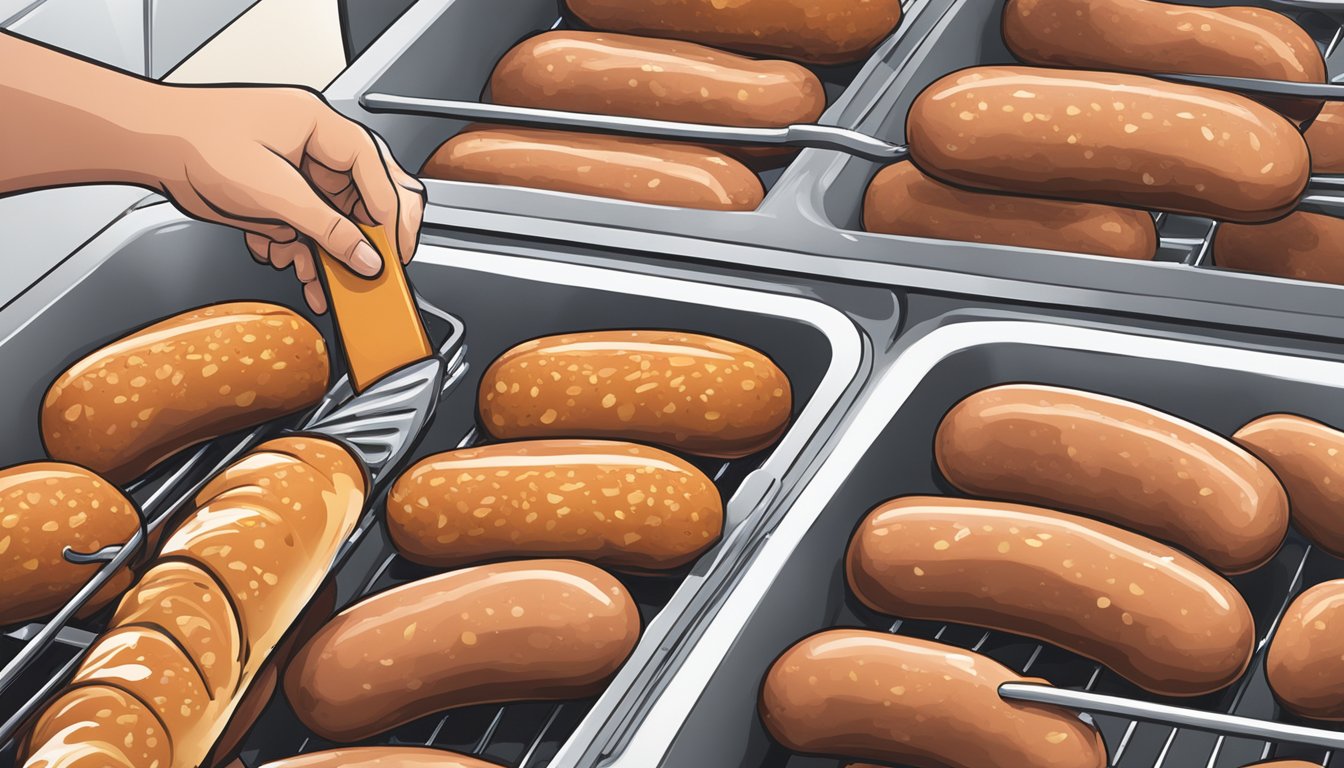Breakfast sausage is a popular morning staple, but improper storage can lead to food waste and safety concerns. Many home cooks wonder if they can refreeze thawed sausages to extend their shelf life. Breakfast sausage can be refrozen, but it’s crucial to follow proper handling and storage guidelines to maintain quality and safety.
Refreezing breakfast sausage is most effective when it has been thawed in the refrigerator and not left at room temperature for extended periods. The process works best with sausages that have been defrosted for less than three days. It’s important to wrap the sausages tightly in freezer-safe packaging or place them in airtight containers before refreezing to prevent freezer burn and maintain flavor.
While refreezing is possible, it may impact the texture and taste of the sausages. To minimize quality loss, consider cooking the thawed sausages before refreezing. This extra step can help preserve the sausages’ integrity and make them ready for quick reheating in future meals.
Understanding Freezing and Refreezing Principles
Freezing breakfast sausage is an effective way to extend its shelf life. When properly frozen, sausages can maintain their quality for up to 2 months.
The freezing process slows down bacterial growth, preserving the food’s safety and flavor. However, it’s crucial to use airtight packaging to prevent freezer burn.
Refreezing thawed sausage is possible, but certain precautions must be taken. Sausages should only be refrozen if they were thawed in the refrigerator within 1-2 days.
Thawing at room temperature for over two hours increases the risk of bacterial growth and should be avoided. For optimal food safety, it’s best to cook thawed sausages before refreezing.
Multiple freeze-thaw cycles can affect the texture and flavor of breakfast sausages. To minimize quality loss, limit refreezing and use vacuum-sealed packaging when possible.
Proper wrapping techniques are essential. Place raw sausages in freezer-safe bags or tightly wrap them in plastic. Remove excess air to reduce the risk of freezer burn.
When refreezing, consider precooking the sausages. This step can help maintain food safety and quality during subsequent thawing and reheating processes.
The Basics of Breakfast Sausage

Breakfast sausage is a versatile and flavorful meat product enjoyed by many. It comes in various forms and can be prepared in multiple ways to suit different tastes and preferences.
Varieties of Breakfast Sausage
Breakfast sausage is available in several varieties. Raw breakfast sausage is typically made from ground pork, seasoned with herbs and spices like sage, thyme, and black pepper. It’s sold in bulk or as patties.
Cooked breakfast sausage offers convenience and is pre-cooked for quick reheating. These often come in links or patties.
Smoked sausage provides a rich, smoky flavor and is fully cooked. It’s usually made from pork or a blend of meats.
Some manufacturers offer turkey or chicken breakfast sausage as a leaner alternative. Vegetarian options made from plant-based proteins are also available.
Selecting Sausage for Freezing
When choosing breakfast sausage for freezing, freshness is key. Look for packages with no signs of freezer burn or ice crystals if buying frozen sausage.
For raw sausage, check the expiration date and ensure the packaging is intact. Opt for vacuum-sealed packages when possible, as they help prevent freezer burn.
Consider portion sizes when selecting sausage for freezing. Individual links or pre-formed patties are convenient for thawing only what’s needed.
Choose high-quality sausage from reputable brands or local butchers. This ensures better flavor and texture after freezing and thawing.
Freezing Breakfast Sausage

Proper freezing techniques preserve the quality and safety of breakfast sausages. Careful preparation and packaging are key to maintaining flavor and texture.
Preparing Sausages for Freezing
Start by portioning the sausages into meal-sized amounts. This allows for easier thawing later. For patties, separate them with wax paper to prevent sticking. Raw sausages should be frozen within 1-2 days of purchase.
If freezing homemade breakfast sausage, cool it completely before packaging. Pre-cooking sausages before freezing can extend their freezer life and make reheating more convenient.
Label packages with the date and quantity to track freshness. Use within 1-2 months for best quality.
Packaging Sausages for the Freezer
Proper packaging prevents freezer burn and maintains flavor. Use freezer-safe bags or airtight containers designed for freezing.
Remove as much air as possible from bags to reduce ice crystal formation. A vacuum sealer provides the best protection against freezer burn.
Wrap individual sausages or patties in plastic wrap before placing in bags. This extra layer helps preserve quality and makes it easy to thaw only what’s needed.
For longer storage, consider double wrapping. Place wrapped sausages in a second freezer bag or container for added protection.
Thawing Breakfast Sausage Safely
Proper thawing techniques are crucial for maintaining the quality and safety of breakfast sausage. Following recommended methods ensures the sausage remains safe to eat while preserving its flavor and texture.
Proper Thawing Techniques
The refrigerator method is the safest way to thaw breakfast sausage. Place the frozen sausage on a plate or in a container on the bottom shelf of the fridge. Allow 24 hours for every 1-2 pounds of sausage to thaw completely.
For quicker thawing, use the cold water method. Seal the sausage in a leak-proof plastic bag and submerge it in cold tap water. Change the water every 30 minutes to maintain a cold temperature. This method takes about 1 hour per pound of sausage.
Never thaw breakfast sausage at room temperature or in hot water. These methods can lead to bacterial growth and food safety risks.
Once thawed, use the sausage within 1-2 days. If plans change, it’s safe to refreeze sausage thawed in the refrigerator, but quality may be affected.
Refreezing Breakfast Sausage
Refreezing breakfast sausage is possible but requires careful handling to maintain food safety and quality. Proper thawing and storage techniques are essential when refreezing sausage.
When Is It Safe to Refreeze Sausage?
It’s safe to refreeze breakfast sausage if it was thawed in the refrigerator and hasn’t been left at room temperature for more than two hours. Raw sausage can be refrozen within 1-2 days of thawing in the fridge. Cooked breakfast sausage can also be refrozen if it was properly refrigerated after cooking.
Sausage thawed in cold water or the microwave should be cooked before refreezing. Never refreeze sausage left at room temperature for extended periods, as this can lead to bacterial growth.
Multiple freeze-thaw cycles can affect texture and flavor, so it’s best to limit refreezing to once if possible.
How to Refreeze Thawed Sausage
To refreeze thawed sausage:
- Cook raw sausage thoroughly to an internal temperature of 165°F (74°C).
- Cool cooked sausage quickly in the refrigerator.
- Package in airtight containers or freezer bags, removing excess air.
- Label with the date and contents.
- Place in the freezer as soon as possible.
For raw sausage that was thawed in the refrigerator, repackage in airtight containers before refreezing. Use vacuum-sealed packaging to minimize freezer burn and maintain quality.
Frozen sausage can typically be stored for 1-2 months without significant quality loss.
Food Safety Considerations
Proper handling and temperature control are crucial when refreezing breakfast sausage. Always thaw sausage in the refrigerator, never at room temperature.
Cook sausage thoroughly to an internal temperature of 165°F (74°C) before refreezing. This eliminates harmful bacteria and ensures food safety.
Freeze cooked breakfast sausage promptly after cooling. Place it in airtight, freezer-safe containers or bags to prevent freezer burn and contamination.
Label and date all refrozen sausage packages. Use within 1-2 months for best quality, though it remains safe indefinitely if stored at 0°F (-18°C) or below.
Avoid refreezing raw sausage that has been thawed at room temperature or left out for more than 2 hours. This can lead to bacterial growth and foodborne illness.
When handling sausage, wash hands thoroughly and use clean utensils and surfaces to prevent cross-contamination.
If in doubt about the safety of refrozen sausage, discard it. It’s better to err on the side of caution to protect your health.
Usage Ideas for Refrozen Sausage

Refrozen breakfast sausage can be a versatile ingredient in various dishes. Its convenience and flavor make it suitable for quick meals and pre-made preparations.
Recipe Inspirations
Refrozen sausage works well in breakfast burritos. Simply crumble and cook the sausage, then combine with scrambled eggs, cheese, and vegetables in a tortilla. For a hearty start to the day, incorporate the sausage into a savory casserole with potatoes, eggs, and cheese.
Omelets benefit from the addition of refrozen sausage. Cook the sausage first, then fold it into a fluffy omelet with your choice of vegetables and cheese. This protein-packed meal is perfect for any time of day.
Sausage rolls make excellent snacks or party appetizers. Wrap thawed and cooked sausage in puff pastry, then bake until golden brown. These can be prepared in advance and frozen again for later use.
Pre-Made Meal Preparations
Refrozen sausage is ideal for meal prepping. Cook a large batch of sausage patties or links, then portion them into individual containers with other breakfast components like eggs and toast. These can be quickly reheated for busy mornings.
Create breakfast sandwiches using English muffins, cheese, and cooked sausage patties. Wrap individually and freeze for a grab-and-go option. These homemade versions are often healthier and more cost-effective than store-bought alternatives.
For a convenient dinner option, prepare a sausage and vegetable sheet pan meal. Combine sliced sausage with chopped vegetables, toss with oil and seasonings, then freeze in portions. This allows for easy cooking on hectic weeknights.
Storing and Shelf Life
Proper storage and understanding shelf life are crucial for maintaining the quality and safety of breakfast sausage. Factors like temperature, packaging, and handling methods impact how long sausages remain fresh.
Optimal Storage Conditions
Refrigerate raw breakfast sausage at 40°F (4°C) or below. Place sausages in the coldest part of the fridge, typically the back of the bottom shelf. Use airtight containers or sealed plastic bags to prevent cross-contamination and odor transfer.
For longer storage, freeze breakfast sausage at 0°F (-18°C) or lower. Wrap sausages tightly in plastic wrap or aluminum foil, then place in freezer bags. Remove as much air as possible to prevent freezer burn.
Vacuum-sealing extends shelf life significantly. This method removes air and creates a barrier against moisture and bacteria.
Determining Shelf Life
Raw breakfast sausage lasts 1-2 days in the refrigerator. Cooked sausages can be safely stored for 3-4 days when properly refrigerated.
Frozen raw breakfast sausage retains quality for up to 2 months. Cooked sausages can be frozen for up to 2 months as well.
Vacuum-sealed raw breakfast sausage lasts 7-10 days in the fridge. When frozen, it can maintain quality for up to 6 months.
Check for signs of spoilage before consuming: off-odors, slimy texture, or discoloration indicate the sausage should be discarded.
Refreezing thawed sausage is safe if it was thawed in the refrigerator and hasn’t been at room temperature for more than 2 hours. However, quality may decrease slightly with each freeze-thaw cycle.




